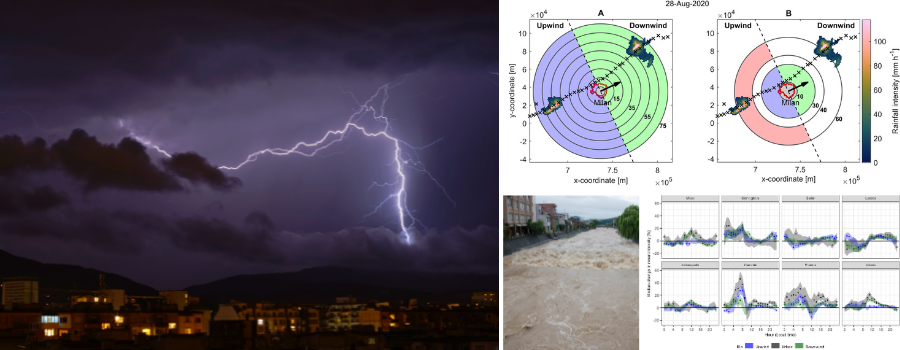Summer storms are generally more frequent and intense over urban areas

Summer storms are generally more frequent, intense and concentrated over cities than over rural areas, according to new, detailed observations of eight cities and their surroundings. The results could change how city planners prepare for floods in their cities, especially as urban areas expand and as climate change alters global weather patterns.
The new study finds that more storms form over urban areas and their boundaries than in surrounding areas, and that larger cities intensify rainfall more than smaller cities. The research was published in Earth’s Future, an open-access AGU journal that publishes interdisciplinary research on the past, present and future of our planet and its inhabitants.
The researchers used seven years of high-resolution weather data from eight cities in Europe and the United States (Milan, Italy; Berlin, Germany; London and Birmingham, United Kingdom; Phoenix, Arizona; Charlotte, North Carolina; Atlanta, Georgia; and Indianapolis, Indiana) to track summer storm formation and intensity in cities and their surroundings. The cities varied in size, climate and urban shape, but all are in relatively flat regions and far from large bodies of water—factors which could influence local rainfall patterns.
The researchers tracked storm formation and evolution outside of and over cities and their boundaries, identifying the average direction, average intensity, maximum intensity and area of each storm.
They found that more storms overall formed over cities and their boundaries compared to nearby rural areas. Storms typically were most intense over city centers, or over the city edges as in Berlin and Birmingham. Larger cities had greater rainfall intensification than smaller cities: in smaller cities, rainfall intensified by 0.9% to 3.4%, while it increased from 5.2% to 11% in the largest cities compared to outlying areas. Some cities also had much higher rainfall intensification during specific times of the day.
Rainfall also became more spatially concentrated over urban areas by up to 15%. Concentrated bursts of rainfall can tax urban water management systems more than rainfall that is evenly distributed.
“Cities are expected to become more populated and increase in size in the coming decades,” said Herminia Torelló-Sentelles, an atmospheric scientist at the University of Lausanne and the study’s lead author. “Being able to quantify urban flood risk is important for urban planning and when designing urban drainage systems.”
Francesco Marra, a researcher from the Department of Geosciences at the University of Padua and an expert on extreme phenomena in the context of climate change, participated in the study. Marra emphasized that intense and brief precipitation is on the rise worldwide due to climate change. He supported the tracking of storm systems and provided the physical interpretation of the study's results. According to Marra, studies of this kind are crucial for optimizing simulations generated by climate models, which often do not accurately represent the physical and microphysical processes associated with urban areas.
Several factors could be causing urban storm creation and intensification, says Torelló-Sentelles. Cities are generally warmer than their cool, moist and vegetation-dense surroundings, which could cause air to be drawn toward the cities and uplifted. That warm, uplifted air then condenses into rainclouds over urban centers.
Storms are also often formed as air is uplifted over mountain ranges, producing rain clouds at the mountains’ peaks. Like mini mountain ranges, city skylines can create favorable environments for the uplift of airmasses and the creation of storms.
“You can think of a city like an obstacle,” said Torelló-Sentelles. “And when a storm is moving toward it, the air can be lifted over and around it.”
Aerosol pollution suspended in the atmosphere over cities may also either enhance or suppress rainfall.

Strong storms increase urban flood risk
Increasingly large urban areas could generate and amplify more storms than their surroundings, even as climate change continues to intensify storms worldwide. The combined impact of urban growth and climate change could stress urban stormwater systems and lead to more frequent and severe floods.
While the researchers found some consistent trends across all cities, every city changed rainfall patterns in unique ways. For instance, while most of the cities had storms with stronger bursts of rainfall than their surroundings, Berlin and Charlotte had more dispersed rainfall. In Atlanta, storms intensified the most in the daytime hours, while storms in Birmingham only intensified overnight. And unlike the other six cities studied, Berlin and Phoenix did not have more storms initiate over the city than in surrounding areas.
These results highlight the need for individual city planning strategies and studies including more cities, said Torelló-Sentelles. As the climate changes and the world urbanizes, individual cities will need to develop their own adaptation and mitigation strategies.
“We need to study a wider variety of cities so that we can generalize findings and determine which city characteristics have the largest effects on cities’ rainfall-modifying potential,” she said. “The mechanisms driving urban rainfall are quite complex, and we still need to research these processes more.”
Notes for Journalists:
This study is published in Earth’s Future with open access. Neither the paper nor this press release is under embargo. View and download a pdf of the study.
PAPER TITLE: “Intensification and changing spatial extent of heavy rainfall in urban areas”
LINK: https://agupubs.onlinelibrary.wiley.com/doi/full/10.1029/2024EF004505
DOI: https://doi.org/10.1029/2024EF004505
AUTHORS:
Herminia Torelló-Sentelles, University of Lausanne, Lausanne, Switzerland
Francesco Marra, University of Padova, Padova, Italy
Marika Koukoula, University of Lausanne, Lausanne, Switzerland
Gabriele Villarini, Princeton University, Princeton, NJ, USA
Nadav Peleg, University of Lausanne, Lausanne, Switzerland





